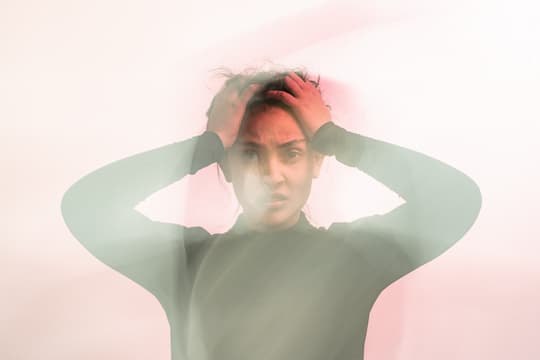How to deal with panic attacks, the signs, symptoms, causes, treatment and how it differs from a heart attack.
What psychologists call ‘panic disorder’ is a little different from the everyday use of the word panic.
Sufferers experience these panic attack symptoms:
- intense fear,
- a very strong physical reaction,
- and the sensation of being about to die or losing complete mental control.
This article covers:
- Physical panic attack symptoms
- When to see a doctor
- Causes
- How to deal with a panic attack
- Complications
- Treatment
- Lifestyle changes
Physical panic attack symptoms
Physical symptoms include:
- shortness of breath,
- chest pain,
- upset stomach,
- sweating and shaking.
That is why many people think they are having a heart attack.
Of course, thinking you are having a heart attack contributes to the panic.
This is all in the face of very little real danger — although it feels very different to the person experiencing it.
When to see a doctor for panic attack symptoms
Often people experiencing panic attack symptoms feel there is a physical problem. This is possible. That is why it is sensible to get checked out by a physician.
If they, or perhaps other people, suggest it could be more psychological, then panic attacks are a possibility.
Panic attacks are quite common among people who experience a lot of anxiety.
Causes
It is not known exactly why some people have panic attacks and others do not but it is likely the following factors are important:
- Large amounts of stress
- Genetic susceptibility
- An anxious personality or being particularly prone to negative emotions
- Changes in brain function
It is estimated that around 1 in 10 people experience at least one panic attack in a year.
They may not be frequent, but can be triggered by a situation or object that provokes deep fears.
For example, people who are fearful of social situations may have a panic attack at a party.
Or, people who are fearful of enclosed spaces might have a panic attack in a lift.
People who primarily have a panic disorder, though, can experience panic attacks apparently in response to little more than being afraid of being afraid.
It is often the fear of having a panic attack that starts the attack itself.
There is a kind of swirl of thoughts at the heart of panic attacks.
How to deal with a panic attack
One of the first steps in addressing panic attack symptoms is understanding and breaking down what is happening.
- Stage 1: The first sign of disaster could be anything small that causes the first twinges of anxiety. It might be an upsetting thought, noticing a fast-beating heart or being in a certain situation.
- Stage 2: As the anxiety grows — usually very rapidly — the physical symptoms get worse. The heart beats faster, the sweats start, the adrenaline flows. These physical sensations only seem to confirm those first twinges of anxiety: it feels as though it must certainly be a heart-attack or some other catastrophic problem.
- Stage 3: Anxious thoughts have now become catastrophic thoughts. Naturally, this leads right back into more anxiety, physical sensations and so on…
Complications
Anxiety attacks should be treated because when they are severe they can interfere with quality of life.
Panic attack symptoms can leave people in a constant state of fear.
Some of the complications related to panic attacks include:
- Often having medical care for health concerns
- Developing specific phobias, such as agoraphobia or fear of driving
- Alcohol or other substance misuse
- Problems with finances
- Avoiding social situations
- Anxiety, depression, or other psychological disorders
- Higher risk of suicidal thoughts
Treatment
More severe panic attack symptoms are best treated by a psychologist or other mental health professional.
Cognitive behavioural therapy is the best treatment for panic attacks.
They will recommend a variety of approaches, which might include:
- Accepting the experience: reminding yourself that the experience will be over soon and you have survived it before.
- Relaxation techniques: guided imagery, progressive muscle relaxation or any other activity that promotes relaxation can all help with panic attack symptoms.
- Mindfulness exercises: Mindfulness involves learning to be in the present moment and to observe thoughts and feelings as they pass through the mind, without holding on to them or fighting them.
- Breathing exercise: Taking slow deep breaths and focusing on those breaths is one of the easiest ways to address panic attacks in the moment. Notice the air filling your stomach as you inhale then count four as you exhale. Be aware of how you breathing slows as you continue to practice the exercise.
Doctors may also recommend medication, such as an antidepressant or antianxiety drug, although therapy is a better treatment for panic attacks.
Therapy does not have serious side-effects, like drugs, and it is not addictive or habits forming, as drugs are.
However sometimes a combination of approaches is recommended.
Lifestyle changes
A range of lifestyle changes may also be beneficial to anxiety attacks.
These can include:
- Taking up meditation or yoga
- Regular amounts of moderate exercise.
- Managing sources of stress
- Lowering or cutting out the consumption of alcohol, drugs, and caffeine.
- Identifying and stopping negative thoughts.
- Eating a balanced diet.
- Using a support group for like-minded people.

